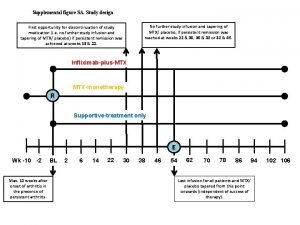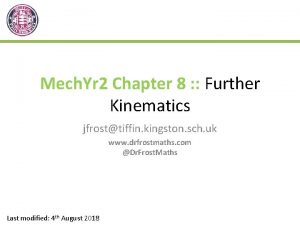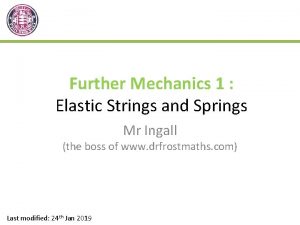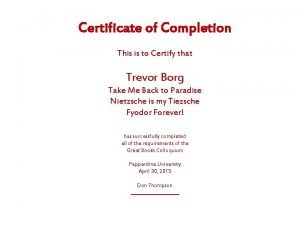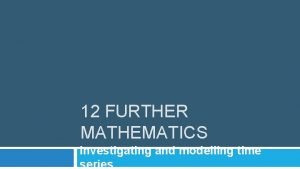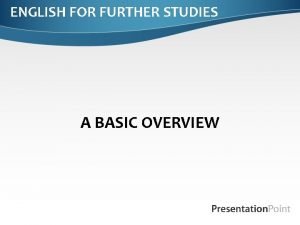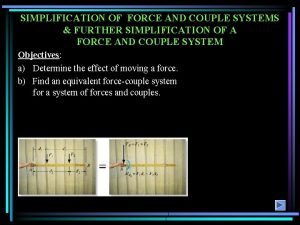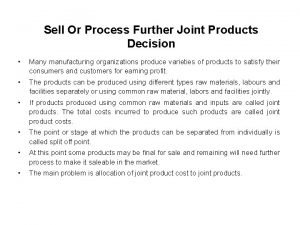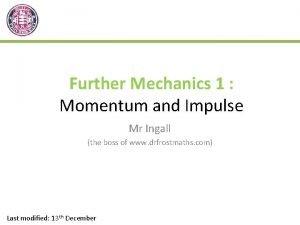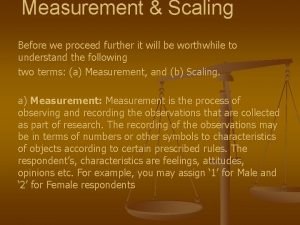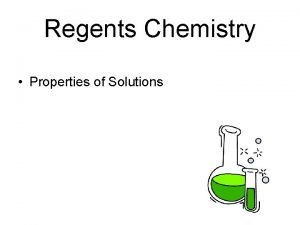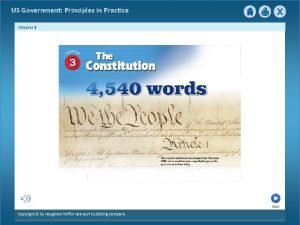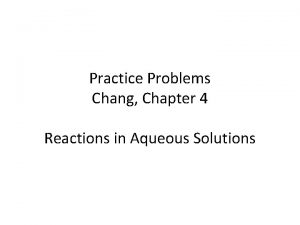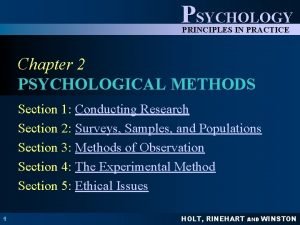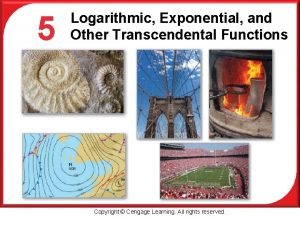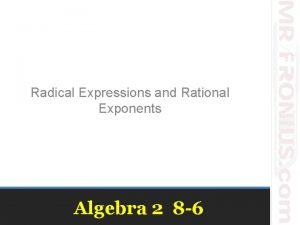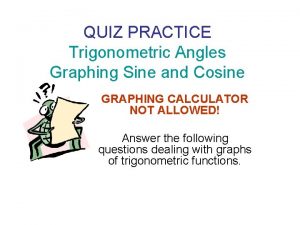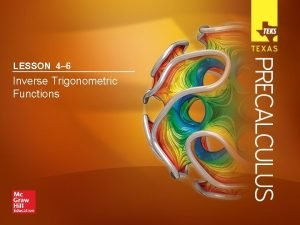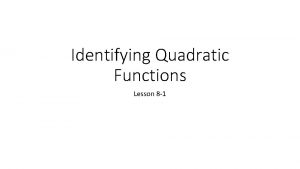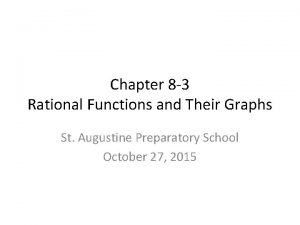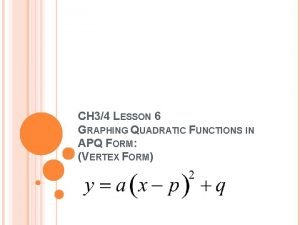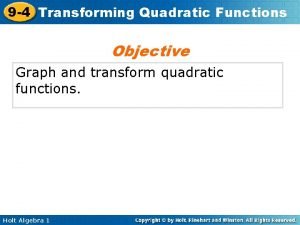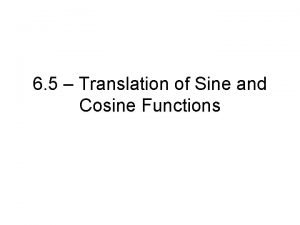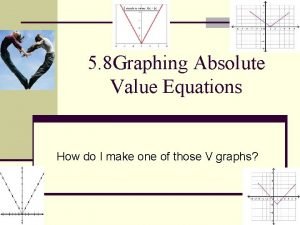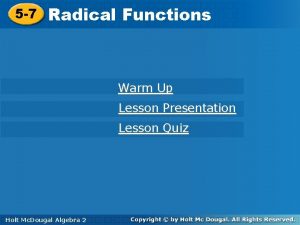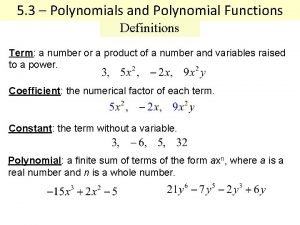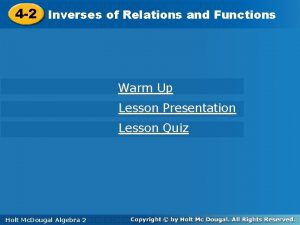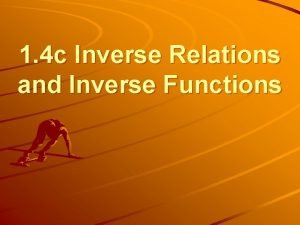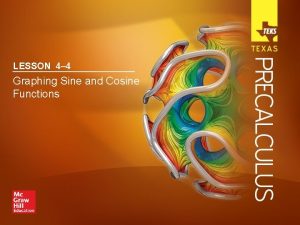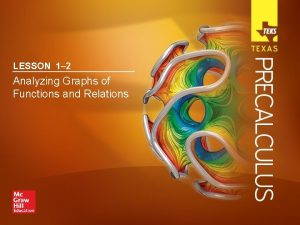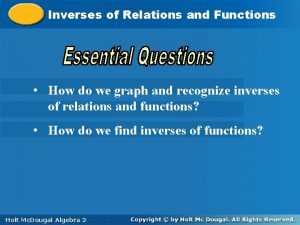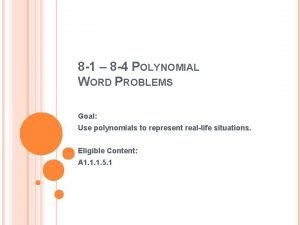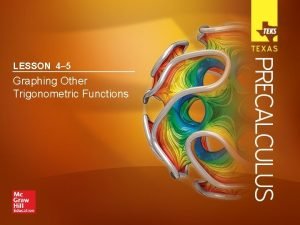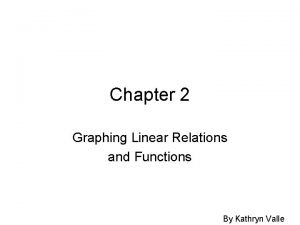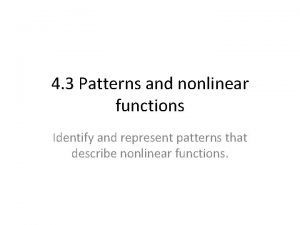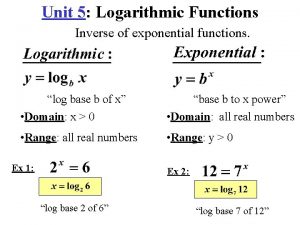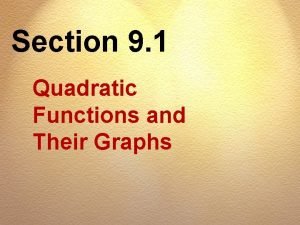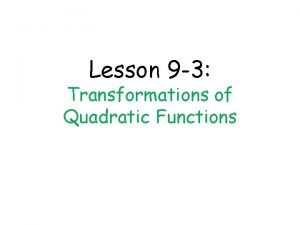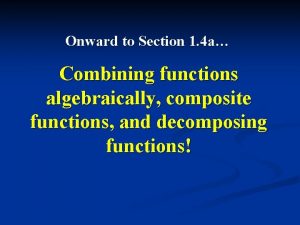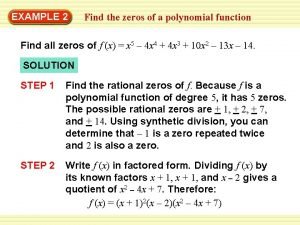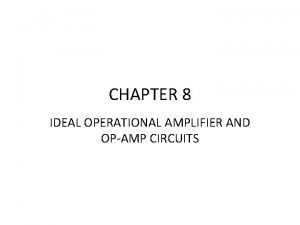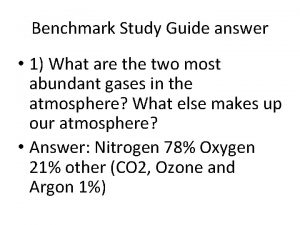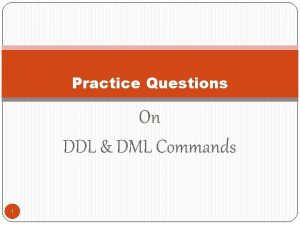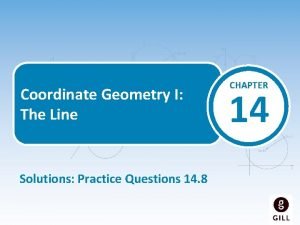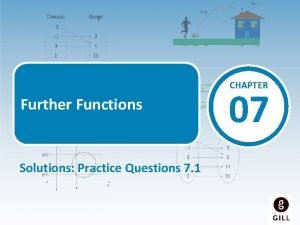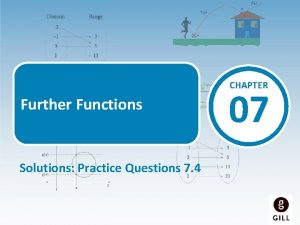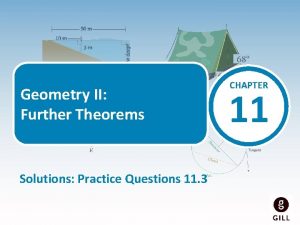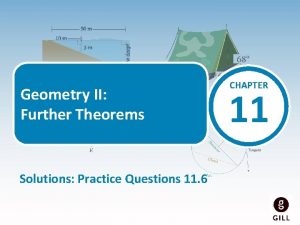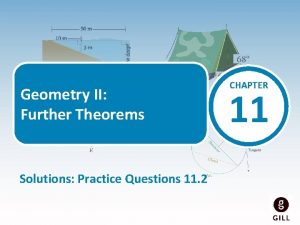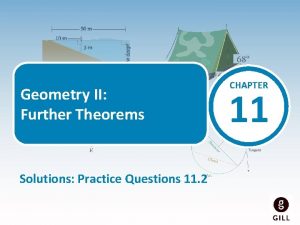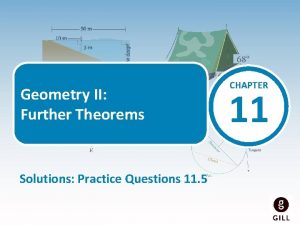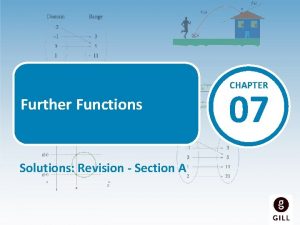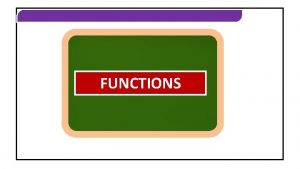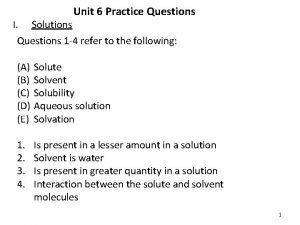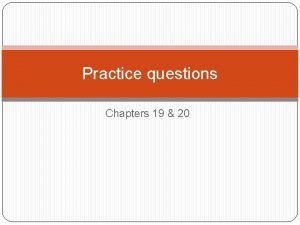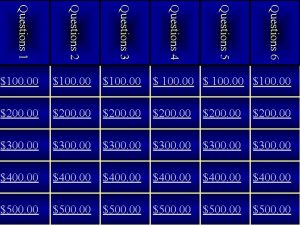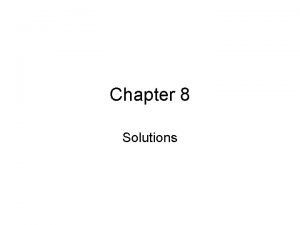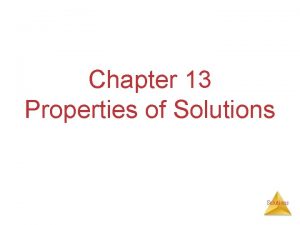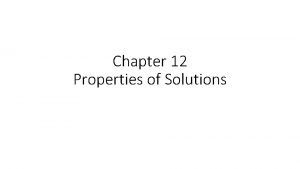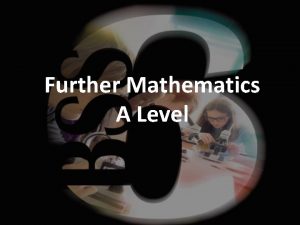CHAPTER Further Functions Solutions Practice Questions 7 6












































































- Slides: 76

CHAPTER Further Functions Solutions: Practice Questions 7. 6 07

Practice Questions 7. 6 07 1. The diagram shows a pair of functions, whereby the output of the first function f, becomes the input of the second function, g. Find the outputs at point B for the following inputs at A: (i) 1 Substitute 1 in as the input, A, in the first function: 3(1) + 4 = 7 Now, substitute the output of 7 in as the input into the second function: (7)2 − 5 = 44 Therefore, an input of 1 at A results in an output of 44 at B.

Practice Questions 7. 6 07 1. The diagram shows a pair of functions, whereby the output of the first function f, becomes the input of the second function, g. Find the outputs at point B for the following inputs at A: (ii) 3 Substitute 3 in as the input, A, in the first function: 3(3) + 4 = 13 Now, substitute the output of 13 in as the input into the second function: (13)2 − 5 = 164 Therefore, an input of 3 at A results in an output of 164 at B.

Practice Questions 7. 6 07 1. The diagram shows a pair of functions, whereby the output of the first function f, becomes the input of the second function, g. Find the outputs at point B for the following inputs at A: (iii) 0 Substitute 0 in as the input, A, in the first function: 3(0) + 4 = 4 Now, substitute the output of 4 in as the input into the second function: (4)2 − 5 = 11 Therefore, an input of 0 at A results in an output of 11 at B.

07 1. Practice Questions 7. 6 The diagram shows a pair of functions, whereby the output of the first function f, becomes the input of the second function, g. Find the outputs at point B for the following inputs at A: (iv) − 2 Substitute − 2 in as the input, A, in the first function: 3(− 2) + 4 = − 2 Now, substitute the output of − 2 in as the input into the second function: (− 2)2 − 5 = − 1 Therefore, an input of − 2 at A results in an output of − 1 at B.

07 1. Practice Questions 7. 6 The diagram shows a pair of functions, whereby the output of the first function f, becomes the input of the second function, g. Find the outputs at point B for the following inputs at A: (v) − 5 Substitute − 5 in as the input, A, in the first function: 3(− 5) + 4 = − 11 Now, substitute the output of − 11 in as the input into the second function: (− 11)2 − 5 = 116 Therefore, an input of − 5 at A results in an output of 116 at B.

07 2. (i) Practice Questions 7. 6 f (x) = 2 x + 1 and g(x) = 5 − x are two functions, where x ∈ ℝ. Find: f (2) f (x) = 2 x + 1 f (2) = 2(2) + 1 =5

07 2. (ii) Practice Questions 7. 6 f (x) = 2 x + 1 and g(x) = 5 − x are two functions, where x ∈ ℝ. Find: g (− 1) g(x) = 5 – x g(− 1) = 5 − (− 1) =5+1 =6

07 2. (iii) Practice Questions 7. 6 f (x) = 2 x + 1 and g(x) = 5 − x are two functions, where x ∈ ℝ. Find: f g (− 1) From part (ii), g (− 1) = 6 f g (− 1) = f (6) = 2(6) + 1 = 12 + 1 = 13

07 2. (iv) Practice Questions 7. 6 f (x) = 2 x + 1 and g(x) = 5 − x are two functions, where x ∈ ℝ. Find: (g ◦ f )(2) From part (i), f (2) = 5 g ◦ f (2) = g(5) =5– 5 =0

07 2. (v) Practice Questions 7. 6 f (x) = 2 x + 1 and g(x) = 5 − x are two functions, where x ∈ ℝ. Find: g ( f (x)) g( f (x)) = g(2 x + 1) = 5 – 2 x – 1 = 4 – 2 x

07 2. (vi) Practice Questions 7. 6 f (x) = 2 x + 1 and g(x) = 5 − x are two functions, where x ∈ ℝ. Find: ( f ◦ g)(− 3) First we must find the value of g(− 3): g(− 3) = 5 − (− 3) =5+3 =8 ( f ◦ g)(− 3) = f(8) = 2(8) + 1 = 17

07 2. Practice Questions 7. 6 f (x) = 2 x + 1 and g(x) = 5 − x are two functions, where x ∈ ℝ. Find: (vii) g 2(5) = g ◦ g(5) First we must find the value of g(5): g(5) = 5 – 5 =0 g 2(5) = g(0) =5– 0 =5

07 2. Practice Questions 7. 6 f (x) = 2 x + 1 and g(x) = 5 − x are two functions, where x ∈ ℝ. Find: (viii) f 2(x) = f(x) ◦ f(x) = f(2 x + 1) = 2(2 x + 1) + 1 = 4 x + 2 + 1 = 4 x + 3

07 3. (i) Practice Questions 7. 6 p(x) = x 2 − 4 and q(x) = 7 x + 1 are two functions, where x ∈ ℝ. Find: p(− 3) p(x) = x 2 – 4 p(− 3) = (− 3)2 – 4 =9– 4 =5

07 3. (ii) Practice Questions 7. 6 p(x) = x 2 − 4 and q(x) = 7 x + 1 are two functions, where x ∈ ℝ. Find: q(5) q(x) = 7 x + 1 q(5) = 7(5) + 1 = 35 + 1 = 36

07 3. (iii) Practice Questions 7. 6 p(x) = x 2 − 4 and q(x) = 7 x + 1 are two functions, where x ∈ ℝ. Find: q p(0) First we must find the value of p(0) = (0)2 – 4 =0– 4 =– 4 q p(0) = q(− 4) = 7(− 4) + 1 = – 28 + 1 = – 27

07 3. (iv) Practice Questions 7. 6 p(x) = x 2 − 4 and q(x) = 7 x + 1 are two functions, where x ∈ ℝ. Find: (p ◦ q)(− 1) First we need to find the value of q(− 1) = 7(− 1) + 1 = – 7 + 1 =– 6 (p ◦ q)(− 1) = p(− 6) = (− 6)2 – 4 = 36 – 4 = 32

07 3. (v) Practice Questions 7. 6 p(x) = x 2 − 4 and q(x) = 7 x + 1 are two functions, where x ∈ ℝ. Find: (q ◦ p)(− 2) First we need to find the value of p(− 2) = (− 2)2 – 4 =4– 4 =0 (q ◦ p)(− 2) = q(0) = 7(0) + 1 =1

07 3. (vi) Practice Questions 7. 6 p(x) = x 2 − 4 and q(x) = 7 x + 1 are two functions, where x ∈ ℝ. Find: q 2(− 2) = q ◦ q(− 2) First we need to find the value of q(− 2) = 7(− 2) + 1 = – 14 + 1 = − 13 q ◦ q(− 2) = q(− 13) = 7(− 13) + 1 = – 90

07 3. Practice Questions 7. 6 p(x) = x 2 − 4 and q(x) = 7 x + 1 are two functions, where x ∈ ℝ. Find: (vii) q (p (x)) = q(x 2 – 4) = 7(x 2 – 4) + 1 = 7 x 2 – 28 + 1 = 7 x 2 – 27

07 3. Practice Questions 7. 6 p(x) = x 2 − 4 and q(x) = 7 x + 1 are two functions, where x ∈ ℝ. Find: (viii) p 2(x) = p ◦ p(x) = p(x 2 – 4) = (x 2 – 4)2 – 4 = (x 2 – 4) – 4 = x 4 – 8 x 2 + 16 – 4 = x 4 – 8 x 2 + 12

07 4. (i) Practice Questions 7. 6 The diagram shows the graphs of two functions, f(x) and g(x). Use the graph to find the value of the following: f (1) When x = 1, y = 3 for the f function f (1) = 3

07 4. (ii) Practice Questions 7. 6 The diagram shows the graphs of two functions, f(x) and g(x). Use the graph to find the value of the following: g(− 3) When x = − 3, y = − 1 for the g function g(− 3) = – 1

07 4. (iii) Practice Questions 7. 6 The diagram shows the graphs of two functions, f(x) and g(x). Use the graph to find the value of the following: f (g(− 3)) g(− 3) = – 1, from part (ii) f g(− 3) = f(− 1) = 5

07 4. (iv) Practice Questions 7. 6 The diagram shows the graphs of two functions, f(x) and g(x). Use the graph to find the value of the following: (g ◦ f )(1) f (1) = 3 from part (i) (g ◦ f )(1) = g(3) = 0

07 4. (v) Practice Questions 7. 6 The diagram shows the graphs of two functions, f(x) and g(x). Use the graph to find the value of the following: g f (− 4) First find f (− 4) = 1, from the graph g f (− 4) = g(1) = – 3

07 4. (vi) Practice Questions 7. 6 The diagram shows the graphs of two functions, f(x) and g(x). Use the graph to find the value of the following: ( f ◦ g )(0) First find g (0) = 0, from the graph f ◦ g(0) = f(0) = 2

07 4. Practice Questions 7. 6 The diagram shows the graphs of two functions, f(x) and g(x). Use the graph to find the value of the following: (vii) g[g (1)] First find g (1) = – 3, from the graph g g(1) = g(− 3) = – 1

07 4. Practice Questions 7. 6 The diagram shows the graphs of two functions, f(x) and g(x). Use the graph to find the value of the following: (viii) f 2(− 2) = f ◦ f(− 2) First find f (− 2) = 2, from the graph f ◦ f(− 2) = f(2) =1

07 5. (i) Practice Questions 7. 6 The diagram shows the graphs of two functions, g(x) and h(x). Use the graph to find the value of the following: h(− 1) When x = − 1, y = 1 for the h function h(− 1) = 1

07 5. (ii) Practice Questions 7. 6 The diagram shows the graphs of two functions, g(x) and h(x). Use the graph to find the value of the following: g(0) When x = 0, y = 3 for the g function g(0) = 3

07 5. (iii) Practice Questions 7. 6 The diagram shows the graphs of two functions, g(x) and h(x). Use the graph to find the value of the following: g(h(− 3)) First find h(− 3) = 4, from the graph g(h(− 3)) = g(4) = 0

07 5. (iv) Practice Questions 7. 6 The diagram shows the graphs of two functions, g(x) and h(x). Use the graph to find the value of the following: (h ◦ g)(− 1) First find g(− 1) = 1, from the graph (h ◦ g)(− 1) = h(1) = – 5

07 5. (v) Practice Questions 7. 6 The diagram shows the graphs of two functions, g(x) and h(x). Use the graph to find the value of the following: h(h(− 4)) First find h(− 4) = 1, from the graph h(h(− 4)) = h(1) = – 5

07 5. (vi) Practice Questions 7. 6 The diagram shows the graphs of two functions, g(x) and h(x). Use the graph to find the value of the following: (g ◦ h)(2) First find h(2) = − 1, from the graph (g ◦ h)(2) = g(− 1) = 1

07 5. Practice Questions 7. 6 The diagram shows the graphs of two functions, g(x) and h(x). Use the graph to find the value of the following: (vii) hg(− 4) First find g(− 4) = 0, from the graph hg(− 4) = h(0) = – 2

07 5. Practice Questions 7. 6 The diagram shows the graphs of two functions, g(x) and h(x). Use the graph to find the value of the following: (viii) g 2(− 2) = (g ◦ g)(− 2) First find g(− 2) = 0, from the graph (g ◦ g)(− 2) = g(0) = 3

07 6. (i) Practice Questions 7. 6 The diagram shows the graphs of two functions, g (x) and f (x). Use the graph to find the value of the following: g(0) = – 5 (ii) f (− 1) = – 3 (iii) g (f (− 1)) = g ( − 3) … not possible to find. Off the scale.

07 6. (iv) Practice Questions 7. 6 The diagram shows the graphs of two functions, g (x) and f (x). Use the graph to find the value of the following: ( f ◦ g )(3) f (2· 5) = 6· 8 (v) g (g (3)) g (2· 5) = 5· 5 (vi) ( g ◦ f )(4) g(3· 1) = 2

07 6. Practice Questions 7. 6 The diagram shows the graphs of two functions, g (x) and f (x). Use the graph to find the value of the following: (vii) f g (− 2) f (1) = 6· 4 (viii) f 2(0) f (3· 2) = 6

07 7. (i) Practice Questions 7. 6 f : x → x 3 + x 2 − 3 x − 5 and g : x → 4 − 3 x are two functions, where x ∈ ℝ: f (2) f(x) = x 3 + x 2 – 3 x – 5 f(2) = (2)3 + (2)2 – 3(2) – 5 =8+4– 6– 5 =1

07 7. (ii) Practice Questions 7. 6 f : x → x 3 + x 2 − 3 x − 5 and g : x → 4 − 3 x are two functions, where x ∈ ℝ: fg(0) g(x) = 4 – 3 x g(0) = 4 – 3(0) =4– 0 =4 fg(0) = f(4) = (4)3 + (4)2 – 3(4) – 5 = 64 + 16 – 12 – 5 = 63

07 7. (iii) Practice Questions 7. 6 f : x → x 3 + x 2 − 3 x − 5 and g : x → 4 − 3 x are two functions, where x ∈ ℝ: gf (− 2) f(− 2) = (− 2)3 + (− 2)2 – 3(− 2) – 5 =– 8+4+6– 5 =– 3 gf (− 2) = g(− 3) = 4 – 3(− 3) =4+9 = 13

07 7. (iv) Practice Questions 7. 6 f : x → x 3 + x 2 − 3 x − 5 and g : x → 4 − 3 x are two functions, where x ∈ ℝ: (f ◦ g)(2) g(2) = 4 – 3(2) =4– 6 = – 2 (f ◦ g)(2) = f(− 2) = (− 2)3 + (− 2)2 – 3(− 2) – 5 =– 8+4+6– 5 =– 3

07 8. (i) Practice Questions 7. 6 f (x) = 6 + 2 x − x 3, g(x) = 3 x 2 + x − 4 and h(x) = 5 x + 2 are three functions, where x ∈ ℝ. Find: h(g(2)) g(x) = 3 x 2 + x – 4 g(2) = 3(2)2 + (2) – 4 = 12 + 2 – 4 = 10 h(g(2)) = h(10) h(x) = 5 x + 2 = 5(10) + 2 = 52

07 8. (ii) Practice Questions 7. 6 f (x) = 6 + 2 x − x 3, g(x) = 3 x 2 + x − 4 and h(x) = 5 x + 2 are three functions, where x ∈ ℝ. Find: f h(0) = 5(0) + 2 =0+2 =2 f h(0) = f (2) f(x) = 6 + 2 x – x 3 = 6 + 2(2) – (2)3 =6+4– 8 =2

07 8. (iii) Practice Questions 7. 6 f (x) = 6 + 2 x − x 3, g(x) = 3 x 2 + x − 4 and h(x) = 5 x + 2 are three functions, where x ∈ ℝ. Find: g(f (1)) f(1) = 6 + 2(1) – (1)3 =6+2– 1 =7 g(f (1)) = g(7) g(x) = 3 x 2 + x – 4 = 3(7)2 + (7) – 4 = 147 + 7 – 4 = 150

07 8. (iv) Practice Questions 7. 6 f (x) = 6 + 2 x − x 3, g(x) = 3 x 2 + x − 4 and h(x) = 5 x + 2 are three functions, where x ∈ ℝ. Find: (f ◦g)(2) g(x) = 3 x 2 + x – 4 g(2) = 3(2)2 + (2) – 4 (f ◦g)(2) = f (10) = 6 + 2(10) – (10)3 = 12 + 2 – 4 = 6 + 20 – 1000 = 10 = – 974

07 8. (v) Practice Questions 7. 6 f (x) = 6 + 2 x − x 3, g(x) = 3 x 2 + x − 4 and h(x) = 5 x + 2 are three functions, where x ∈ ℝ. Find: f g(− 1) g(x) = 3 x 2 + x – 4 g(− 1) = 3(− 1)2 + (− 1) – 4 f g(− 1) = f (− 2) =3– 1– 4 = 6 + 2(− 2) − (− 2)3 =– 2 =6− 4+8 = 10

07 8. (vi) Practice Questions 7. 6 f (x) = 6 + 2 x − x 3, g(x) = 3 x 2 + x − 4 and h(x) = 5 x + 2 are three functions, where x ∈ ℝ. Find: (h ◦ f)(− 2) f (− 2) = 6 + 2(− 2) – (− 2)3 (h ◦ f )(− 2) = h(10) =6– 4+8 = 5(10) + 2 = 10 = 52

07 8. Practice Questions 7. 6 f (x) = 6 + 2 x − x 3, g(x) = 3 x 2 + x − 4 and h(x) = 5 x + 2 are three functions, where x ∈ ℝ. Find: (vii) h 2(− 3) = h ◦ h(− 3) = 5(− 3) + 2 h ◦ h(− 3) = h(− 13) = 5(− 13) + 2 = – 15 + 2 = – 65 + 2 = – 13 = – 63

07 8. Practice Questions 7. 6 f (x) = 6 + 2 x − x 3, g(x) = 3 x 2 + x − 4 and h(x) = 5 x + 2 are three functions, where x ∈ ℝ. Find: (viii) (f ◦(g ◦ h))(− 1) f ◦ g ◦ h(− 1) = 5(− 1) + 2 = – 5 + 2 = – 3 f ◦ g ◦ h(− 1) = f ◦ g(− 3) = 3(− 3)2 + (− 3) – 4 f ◦ g ◦ h(− 1) = f ◦ g(− 3) = f(20) f (20) = 6 + 2(20) – (20)3 = 27 – 3 – 4 = 6 + 40 – 8000 = 20 = – 7954

07 9. (i) Practice Questions 7. 6 f (x) = 5 + 2 x − x 2, h(x) = 5 x + 2 and g(x) = 2 x are three functions, where x ∈ ℝ. Find: h (g (1)) g(x) = 2 x h (g (1)) = h(2) g(1) = 21 h(x) = 5 x + 2 =2 = 5(2) + 2 = 12

07 9. (ii) Practice Questions 7. 6 f (x) = 5 + 2 x − x 2, h(x) = 5 x + 2 and g(x) = 2 x are three functions, where x ∈ ℝ. Find: g h (0) h(x) = 5 x + 2 h(0) = 5(0) + 2 g h (0) = g(2) = 2 x =0+2 = 22 =2 =4

07 9. (iii) Practice Questions 7. 6 f (x) = 5 + 2 x − x 2, h(x) = 5 x + 2 and g(x) = 2 x are three functions, where x ∈ ℝ. Find: g ( f (1)) f (x) = 5 + 2 x – x 2 f (1) = 5 + 2(1) – (1)2 g ( f (1)) = g(6) =5+2– 1 = 26 =6 = 64

07 9. (iv) Practice Questions 7. 6 f (x) = 5 + 2 x − x 2, h(x) = 5 x + 2 and g(x) = 2 x are three functions, where x ∈ ℝ. Find: (f ◦ g)(2) g(2) = 22 =4 (f ◦ g)(2) = f(4) = 5 + 2(4) – 42 = 5 + 8 – 16 =– 3

07 9. (v) Practice Questions 7. 6 f (x) = 5 + 2 x − x 2, h(x) = 5 x + 2 and g(x) = 2 x are three functions, where x ∈ ℝ. Find: g 2(3) = g ◦ g(3) = 23 =8 g ◦ g(3) = g(8) = 28 = 256

07 9. (vi) Practice Questions 7. 6 f (x) = 5 + 2 x − x 2, h(x) = 5 x + 2 and g(x) = 2 x are three functions, where x ∈ ℝ. Find: (h ◦ f)(− 3) f(− 3) = 5 + 2(− 3) − (− 3)2 (h ◦ f)(− 3) = h(− 10) =5– 6– 9 = 5(− 10) + 2 = – 10 = – 50 + 2 = – 48

07 9. Practice Questions 7. 6 f (x) = 5 + 2 x − x 2, h(x) = 5 x + 2 and g(x) = 2 x are three functions, where x ∈ ℝ. Find: (vii) g f (− 2) = 5 + 2(− 2) – (− 2)2 g f (− 2) = g(− 3) =5– 4– 4 = 2– 3 = =

07 9. Practice Questions 7. 6 f (x) = 5 + 2 x − x 2, h(x) = 5 x + 2 and g(x) = 2 x are three functions, where x ∈ ℝ. Find: (viii) ( f ◦(h ◦g))(− 1) g(− 1) = 2− 1 = ( f ◦(h ◦g))(− 1) = f ◦ h = f(4· 5) = 5 + 2(4· 5) – (4· 5)2 = 5 + 9 – 20· 25 = – 6· 25

07 Practice Questions 7. 6 10. (i) Find the velocity of the object after: (a) two seconds v(x) = 5 + 3 x v(2) = 5 + 3(2) =5+6 = 11 m/s

07 Practice Questions 7. 6 10. (i) Find the velocity of the object after: (b) four seconds v(x) = 5 + 3 x v(4) = 5 + 3(4) = 5 + 12 = 17 m/s

07 Practice Questions 7. 6 10. (i) Find the velocity of the object after: (c) 12 seconds v(x) = 5 + 3 x v(12) = 5 + 36 = 41 m/s

07 Practice Questions 7. 6 10. (i) Find the velocity of the object after: (d) 20 seconds v(x) = 5 + 3 x v(20) = 5 + 3(20) = 5 + 60 = 65 m/s

07 Practice Questions 7. 6 10. (ii) Hence, find the kinetic energy the object has, at each of the times given in part (i). (a) k(v) = 200 v 2 k(11) = 200(11)2 = 200(121) = 24, 200 J

07 Practice Questions 7. 6 10. (ii) Hence, find the kinetic energy the object has, at each of the times given in part (i). (b) k(v) = 200 v 2 k(17) = 200(17)2 = 57, 800 J

07 Practice Questions 7. 6 10. (ii) Hence, find the kinetic energy the object has, at each of the times given in part (i). (c) k(v) = 200 v 2 k(41) = 200(41)2 = 336, 200 J

07 Practice Questions 7. 6 10. (ii) Hence, find the kinetic energy the object has, at each of the times given in part (i). (d) k(v) = 200 v 2 k(65) = 200(65)2 = 845, 000 J

07 Practice Questions 7. 6 10. (iii) Write an expression, in x, for the amount of kinetic energy the object has after x seconds. v(x) = 5 + 3 x k(v) = 200 v 2 Substitute v(x) = 5 + 3 x into the k(v) function k(v) = 200 v 2 k(5 + 3 x) = 200(5 + 3 x)2 (The amount of kinetic energy of the object after x seconds)

07 11. (i) Practice Questions 7. 6 A shop has reduced the price of all laptops by 30%. Find the sale price of a laptop, if it was originally priced at € 750. Discount of 30% Sale price = 70% of € 750 = € 525

07 11. (ii) Practice Questions 7. 6 A shop has reduced the price of all laptops by 30%. On a given day, the shop is offering a special discount of 10% off all sale prices. Find the discounted price of the laptop. 10% off € 525 = € 52· 5 € 525 – € 52· 50 € 472· 50

07 11. (iii) Practice Questions 7. 6 A shop has reduced the price of all laptops by 30%. What is the overall percentage discount applied to the laptop? Discount = € 750 – € 472· 50 = € 277· 50 Overall percentage discount = 100

07 11. (iv) Practice Questions 7. 6 A shop has reduced the price of all laptops by 30%. If x is the original price of a laptop, write an expression for s(x), the price of the laptop in the 30% off sale. s(x) = 0· 7 x (70% of original price x)

07 11. (v) Practice Questions 7. 6 A shop has reduced the price of all laptops by 30%. Write an expression for d(y), the price of the laptop, after the additional 10% discount is applied, where y is the sale price. d(y) = 0· 9 y (90% of sale price y)

07 11. (vi) Practice Questions 7. 6 A shop has reduced the price of all laptops by 30%. Hence, find the composite function, ds(x), the price of a €x laptop, after both discounts have been applied. Use this composite function to verify your answer to part (iii). ds(x) = d ◦ s(x) = d(0· 7 x) = 0· 9(0· 7 x) = 0· 63 x For x = € 750 ds(x) = 0· 63 x = 0· 63(750) = € 472· 50 which verifies the answer to part (iii)
 Difference between further and furthermore
Difference between further and furthermore Further study design
Further study design Fantail ship
Fantail ship Dr frost further kinematics
Dr frost further kinematics Further mechanics elastic strings and springs
Further mechanics elastic strings and springs Not for distribution confidential
Not for distribution confidential This is to certify that
This is to certify that Further applications of integration
Further applications of integration Further applications of integration
Further applications of integration Time series further maths
Time series further maths Havering college of further and higher education
Havering college of further and higher education Life is a highway metaphor
Life is a highway metaphor English for further studies
English for further studies Further applications of integration
Further applications of integration Information letter
Information letter Couple systems
Couple systems Sell or process further decision
Sell or process further decision Further mechanics 1 unit test 1 momentum and impulse
Further mechanics 1 unit test 1 momentum and impulse For further information please visit our website
For further information please visit our website Further applications of integration
Further applications of integration Itemised rating scale
Itemised rating scale Further applications of integration
Further applications of integration Further applications of integration
Further applications of integration Further education support service
Further education support service Myerscough college foundation learning
Myerscough college foundation learning Solutions chemistry regents questions
Solutions chemistry regents questions Computer security principles and practice solutions
Computer security principles and practice solutions United states government principles in practice
United states government principles in practice Reactions in aqueous solutions practice problems
Reactions in aqueous solutions practice problems Psychology principles in practice
Psychology principles in practice Transcendental functions examples with solutions
Transcendental functions examples with solutions Myeplg website
Myeplg website Radical functions and rational exponents practice
Radical functions and rational exponents practice Graphing sine and cosine quiz
Graphing sine and cosine quiz Technology applications teks
Technology applications teks Lesson 8 quadratic functions page 339
Lesson 8 quadratic functions page 339 Polynomial function form
Polynomial function form Vertical answer
Vertical answer 9-1 practice graphing quadratic functions
9-1 practice graphing quadratic functions Narrowest graph example
Narrowest graph example 6-5 practice translations of sine and cosine functions
6-5 practice translations of sine and cosine functions Graphing absolute value functions worksheet doc
Graphing absolute value functions worksheet doc 5-7 practice b radical functions answers
5-7 practice b radical functions answers 5-3 skills practice polynomial functions
5-3 skills practice polynomial functions 6-2 inverse functions and relations
6-2 inverse functions and relations 1-4 inverses of functions
1-4 inverses of functions 4-4 graphing sine and cosine functions
4-4 graphing sine and cosine functions Lesson 1 analyzing a graph
Lesson 1 analyzing a graph Investigating graphs of polynomial functions
Investigating graphs of polynomial functions 4-2 practice b inverses of relations and functions
4-2 practice b inverses of relations and functions Polynomial word problems examples
Polynomial word problems examples 4-5 practice graphing other trigonometric functions
4-5 practice graphing other trigonometric functions 2-2 practice linearity and symmetry
2-2 practice linearity and symmetry 4-3 patterns and nonlinear functions
4-3 patterns and nonlinear functions 2-6 practice special functions
2-6 practice special functions Functions jeopardy
Functions jeopardy Inverse of log function
Inverse of log function Solve the system of inequalities by graphing y -x+3 y x-1
Solve the system of inequalities by graphing y -x+3 y x-1 Dilations of quadratic functions
Dilations of quadratic functions Combining functions practice
Combining functions practice Zero polynomial
Zero polynomial Ideal opamp
Ideal opamp Benchmark 2 study questions solutions
Benchmark 2 study questions solutions Absolute value piecewise function
Absolute value piecewise function Evaluating functions
Evaluating functions Evaluating functions and operations on functions
Evaluating functions and operations on functions How to calculate percent yield in organic chemistry
How to calculate percent yield in organic chemistry Restorative circle questions
Restorative circle questions Statutory interpretation practice exam
Statutory interpretation practice exam Abfm study guide
Abfm study guide Ddl practice questions
Ddl practice questions Osslt essay
Osslt essay Oedipus multiple choice questions
Oedipus multiple choice questions Restorative practice circle questions
Restorative practice circle questions Cpn test
Cpn test Coordinate geometry practice questions
Coordinate geometry practice questions Sat words in context practice questions
Sat words in context practice questions

